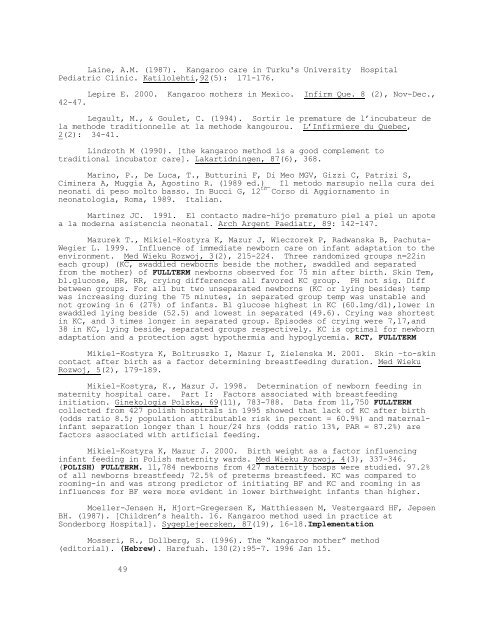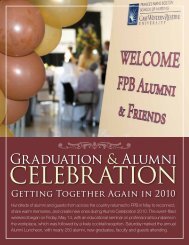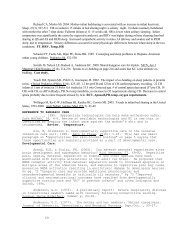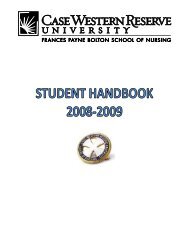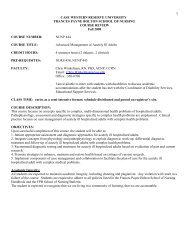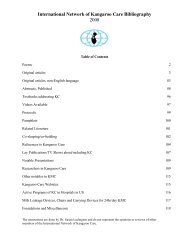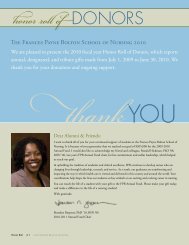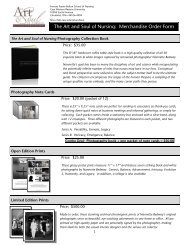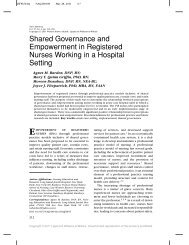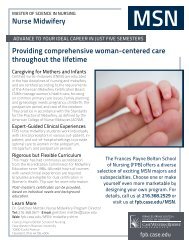Kangaroo Care BIBLIOGRAPHY Develope
Kangaroo Care BIBLIOGRAPHY Develope
Kangaroo Care BIBLIOGRAPHY Develope
Create successful ePaper yourself
Turn your PDF publications into a flip-book with our unique Google optimized e-Paper software.
Laine, A.M. (1987). <strong>Kangaroo</strong> care in Turku's University Hospital<br />
Pediatric Clinic. Katilolehti,92(5): 171-176.<br />
Lepire E. 2000. <strong>Kangaroo</strong> mothers in Mexico. Infirm Que. 8 (2), Nov-Dec.,<br />
42-47.<br />
Legault, M., & Goulet, C. (1994). Sortir le premature de l’incubateur de<br />
la methode traditionnelle at la methode kangourou. L’Infirmiere du Quebec,<br />
2(2): 34-41.<br />
Lindroth M (1990). [the kangaroo method is a good complement to<br />
traditional incubator care]. Lakartidningen, 87(6), 368.<br />
Marino, P., De Luca, T., Butturini F, Di Meo MGV, Gizzi C, Patrizi S,<br />
Ciminera A, Muggia A, Agostino R. (1989 ed.)_ Il metodo marsupio nella cura dei<br />
neonati di peso molto basso. In Bucci G, 12 th Corso di Aggiornamento in<br />
neonatologia, Roma, 1989. Italian.<br />
Martinez JC. 199l. El contacto madre-hijo prematuro piel a piel un apote<br />
a la moderna asistencia neonatal. Arch Argent Paediatr, 89: 142-147.<br />
Mazurek T., Mikiel-Kostyra K, Mazur J, Wieczorek P, Radwanska B, Pachuta-<br />
Wegier L. 1999. Influence of immediate newborn care on infant adaptation to the<br />
environment. Med Wieku Rozwoj, 3(2), 215-224. Three randomized groups n=22in<br />
each group) (KC, swaddled newborns beside the mother, swaddled and separated<br />
from the mother) of FULLTERM newborns observed for 75 min after birth. Skin Tem,<br />
bl.glucose, HR, RR, crying differences all favored KC group. PH not sig. Diff<br />
between groups. For all but two unseparated newborns (KC or lying besides) temp<br />
was increasing during the 75 minutes, in separated group temp was unstable and<br />
not growing in 6 (27%) of infants. Bl glucose highest in KC (60.1mg/dl),lower in<br />
swaddled lying beside (52.5) and lowest in separated (49.6). Crying was shortest<br />
in KC, and 3 times longer in separated group. Episodes of crying were 7,17,and<br />
38 in KC, lying beside, separated groups respectively. KC is optimal for newborn<br />
adaptation and a protection agst hypothermia and hypoglycemia. RCT, FULLTERM<br />
Mikiel-Kostyra K, Boltruszko I, Mazur I, Zielenska M. 2001. Skin –to-skin<br />
contact after birth as a factor determining breastfeeding duration. Med Wieku<br />
Rozwoj, 5(2), 179-189.<br />
Mikiel-Kostyra, K., Mazur J. 1998. Determination of newborn feeding in<br />
maternity hospital care. Part I: Factors associated with breastfeeding<br />
initiation. Ginekologia Polska, 69(11), 783-788. Data from 11,750 FULLTERM<br />
collected from 427 polish hospitals in 1995 showed that lack of KC after birth<br />
(odds ratio 8.5; population attributable risk in percent = 60.9%) and maternalinfant<br />
separation longer than 1 hour/24 hrs (odds ratio 13%, PAR = 87.2%) are<br />
factors associated with artificial feeding.<br />
Mikiel-Kostyra K, Mazur J. 2000. Birth weight as a factor influencing<br />
infant feeding in Polish maternity wards. Med Wieku Rozwoj, 4(3), 337-346.<br />
(POLISH) FULLTERM. 11,784 newborns from 427 maternity hosps were studied. 97.2%<br />
of all newborns breastfeed; 72.5% of preterms breastfeed. KC was compared to<br />
rooming-in and was strong predictor of initiating BF and KC and rooming in as<br />
influences for BF were more evident in lower birthweight infants than higher.<br />
Moeller-Jensen H, Hjort-Gregersen K, Matthiessen M, Vestergaard HF, Jepsen<br />
BH. (1987). [Children’s health. 16. <strong>Kangaroo</strong> method used in practice at<br />
Sonderborg Hospital]. Sygeplejeersken, 87(19), 16-18.Implementation<br />
Mosseri, R., Dollberg, S. (1996). The “kangaroo mother” method<br />
(editorial). (Hebrew). Harefuah. 130(2):95-7. 1996 Jan 15.<br />
49


